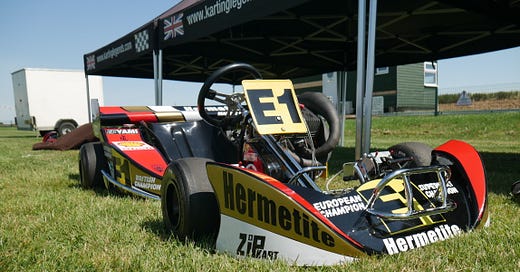Superkarts 'gives an impression of a sport with a lingering inferiority complex searching for some self-respect!'
Nothing cuts like a 'Your Letters" Submission from 1979.
A sport with a lingering inferiority complex, searching for some self-respect.
The art of the 'Your Letters' section in magazines has long been a source of razor-sharp analysis. Sometimes, it even outshines the so-called professionals. Of course, it's a dying art, as magazines themselves dissolve into the winds of history, but they remain my first port of call whenever I pick one up.
I sometimes wonder whether certain letters are merely editorial plants, tools designed to stoke controversy and debate. My sceptical eye often lands on old karting magazines with this in mind, but in this case, I take the following example at face value—because it is as scathing as it is insightful.
Mr P. Roberts of Milton Keynes, writing to Kart and Superkart in their August 1979 edition, wastes no time in getting to the point. Holding himself up as one of the rare hardcore spectators of long-circuit kart racing, he immediately cuts to the heart of the matter:
"I am anxious to see it compete in the popularity stakes with other forms of motor sport, especially in terms of spectator appeal."
He goes on:
"Reading your magazine, though, gives an impression of a sport not knowing quite which direction it wants to go. With the impetus given by the Silverstone Grand Prix meeting last year, it seemed that, at last, the necessary breakthrough had been made. Since then, however, from my side of the fence, little seems to have improved. The image still comes across of a sport with a lingering inferiority complex, searching for some self-respect."
Slow down, Mr Roberts, let us recover for a moment.
"Surely the time has come to stop trying to attract spectators by putting out such wild claims as '150 mph Superkarts' and 'lap speeds comparable with F3 cars' when we all know these are impossible goals for current machinery."
He has a point. Some of the claims at the time were likely exaggerated, though in hindsight, a modern Superkart now laps at around the same pace as a late 70s Formula 1 car, or a modern GT3. they are insanely quick given the top-speed disadvantages.
But Mr Roberts' most cutting critique is yet to come:
"Instead, it would be preferable if more effort was put into tidying up the visual presentation and getting rid of the impression that kart meetings are run purely for the benefit of the competitors themselves, who don’t always seem to appreciate that racing circuits rely on spectator attendance for their survival."
This observation is particularly fascinating because it speaks to a massive cultural and economic shift the sport underwent in the 1980s and 1990s. The idea that tracks relied on spectators to sustain their business is almost alien in a modern context. Yes, spectator events remain an important revenue stream, but the 'customer driver' model now dominates. Track days and competitor-funded racing have largely supplanted spectator-focused events.
Mr Roberts continued:
"Most spectators expect something for their money when they walk through the gates and like to feel that 'the show' is for their entertainment without them having to exert too much mental effort in understanding what they’re watching. To this end, many improvements could be made."
This devastating critique still holds weight today. We live in an era saturated with articles on 'how to get sponsorship' and motorsport marketing, yet there is virtually nothing on improving the experience for those who pay at the gate. Without them, everything else is meaningless from a marketing & PR standpoint.
The mental effort required to follow motorsport like Superkarts is high, especially for a newcomer wandering into the paddock. This was true then and is even truer now. In fact, Superkarts have all but disappeared into the niche ether of motorsport, making them nearly impossible to follow.
Roberts put forward a number of suggestions to improve the sport’s appeal for spectators. He called for compulsory front fairings and more flamboyant colours to help distinguish karts in the pack. Larger number plates were another must, as well as clearer race formats in both programmes and commentary. He criticised lacklustre race commentary, which often failed to generate excitement, and argued that karts should be better presented—many, in his words, looked "bloody awful." He also pointed out safety concerns, noting how some drivers abandoned their karts in dangerous positions on track, much to the frustration of marshals.
He ends with this rallying cry:
"For the promotion of karting, Silverstone must be THE example to follow. Please follow that example, and hopefully, I and other keen kart spectators might one day have the pleasure of watching methanol-burning 350 cc ULTIMAKARTS lapping faster than F3s and touching 150 mph plus!"
The funny thing is, Superkarts did, in many respects, end up where he envisioned. They now lap faster than late-70s F3 cars and do indeed approach 150 mph. And yet, paradoxically, they have fewer hardcore spectators than they did back then - a rather spectacular feat, considering Mr P. Roberts might have been the sole one at the time.
As we march into the 2025 season, one can't help but think Mr Roberts would despair. While Superkarts received some decent attention in the late '70s and early '80s, they have since faded into obscurity. He would likely have followed them all the same, just as he did then.
It remains no less fascinating, in many respects, even more so, but the sport must be roused from its stupor if it is ever to regain its lost momentum.
Alan Dove




